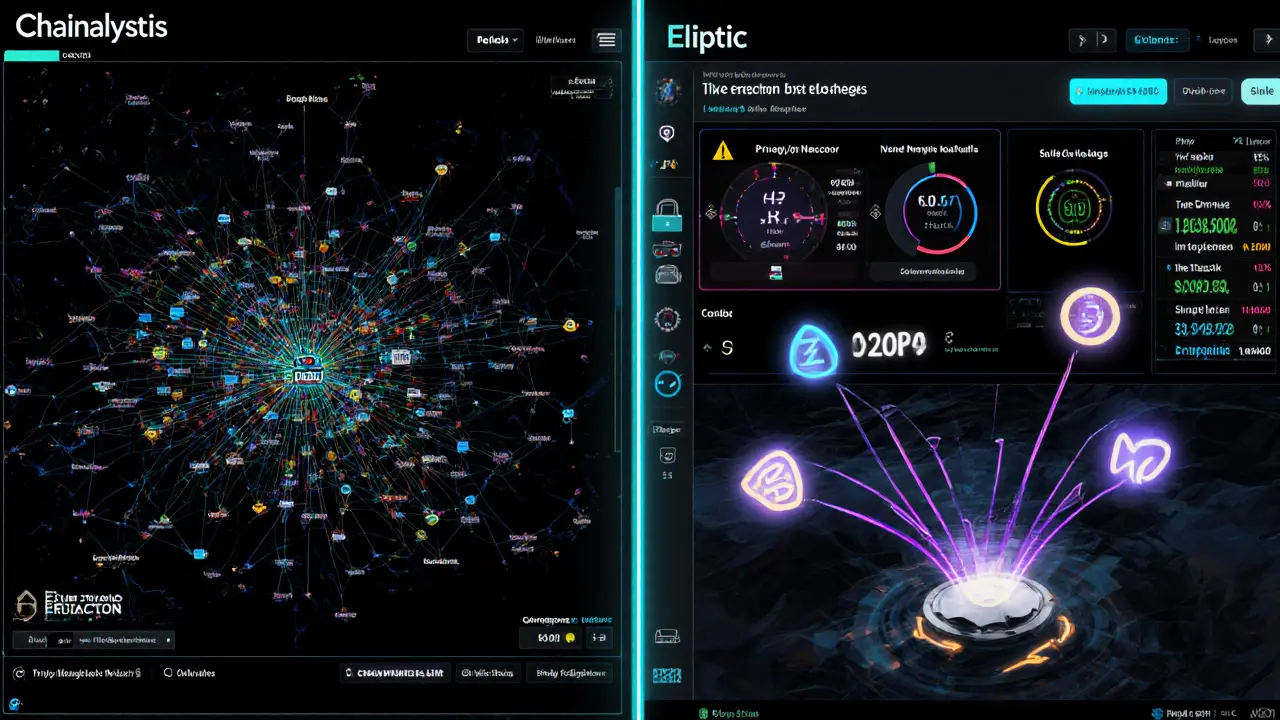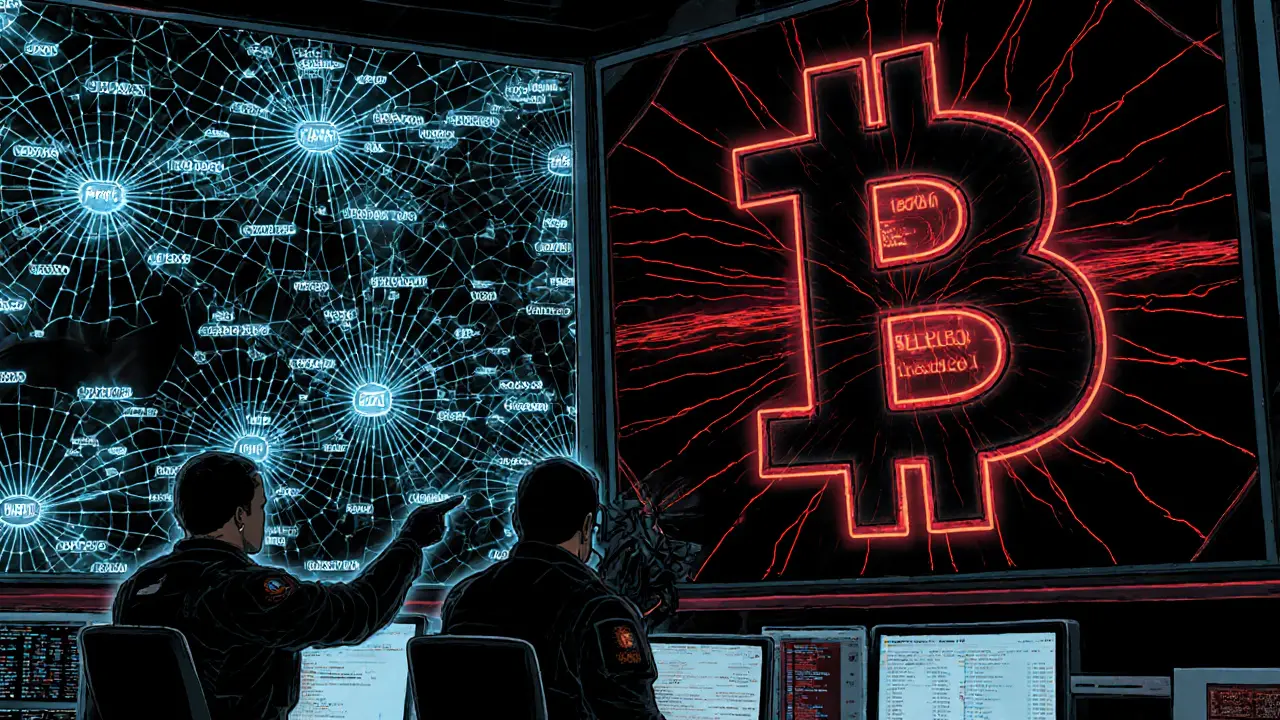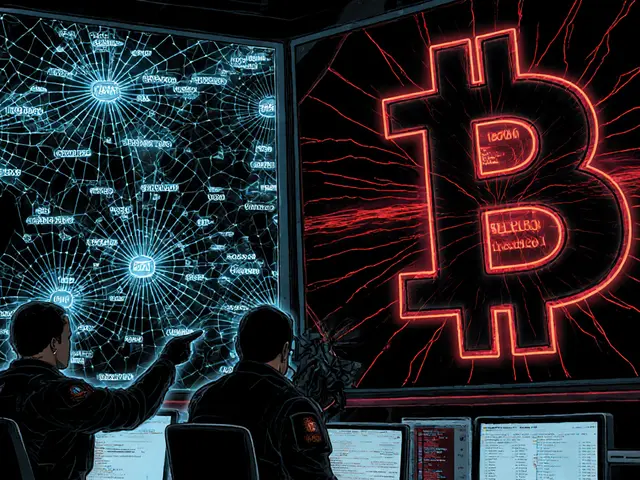Crypto Transaction Risk Assessment Tool
Transaction Risk Calculator
Assess the risk score of your cryptocurrency transaction based on real-world forensics criteria
Why blockchain forensics tools matter now more than ever
Bitcoin isn’t anonymous. Ethereum isn’t private. Every transaction ever made on these networks is public, permanent, and traceable. That’s not a bug-it’s the design. But for criminals, that openness is a liability. And for regulators, it’s a lifeline. That’s where tools like Chainalysis and Elliptic come in. They don’t hack wallets or crack passwords. They read the blockchain like a book-page by page, transaction by transaction-and show you who sent what, where it went, and who might be behind it.
When the FBI seized $1 billion in Bitcoin from the Silk Road darknet marketplace in 2013, they didn’t guess. They used blockchain forensics. That same toolset is now used daily by banks, exchanges, and law enforcement around the world to track ransomware payments, money laundering rings, and terrorist financing. If you’re running a crypto business, ignoring these tools isn’t just risky-it’s illegal under AML laws in most countries.
Chainalysis: The investigator’s toolkit
Chainalysis Reactor is what most law enforcement agencies reach for when they need to trace a crypto trail. It doesn’t just show you addresses and amounts. It connects the dots. If a wallet receives funds from a known darknet marketplace, Chainalysis flags it. If that same wallet then sends coins to a centralized exchange, it traces the withdrawal to a specific KYC-verified user account. That’s how they found the hackers behind the Poly Network breach in 2021-and recovered over $200 million.
Chainalysis covers 85% of the total cryptocurrency market value. That means it tracks Bitcoin, Ethereum, USDT, Solana, and the big players. It doesn’t try to track every obscure token-just the ones that move real money. Its strength? Visualization. You can click on a wallet and see a spiderweb of transactions stretching back years. It clusters wallets that belong to the same entity-like linking 47 different addresses to one darknet vendor. That’s not magic. It’s pattern recognition trained on billions of real transactions.
Chainalysis KYT (Know Your Transaction) is the real-time version. Exchanges use it to block risky deposits before they hit the ledger. If a user tries to deposit $50,000 from a wallet that previously received ransomware payments, KYT flags it instantly. Banks like Barclays and MUFG use it to meet their AML obligations. It’s not perfect-false positives happen-but it’s the most widely trusted system in government and finance circles.
Elliptic: The compliance engine for crypto businesses
Where Chainalysis leans into investigations, Elliptic leans into prevention. It doesn’t just look backward-it predicts forward. Elliptic’s platform monitors 100+ cryptocurrencies, including privacy coins like Zcash and Horizen that most tools ignore. That’s critical because criminals love privacy coins. Elliptic doesn’t just track them-it understands how they’re used in mixers and decentralized exchanges.
Elliptic’s API lets crypto platforms embed risk scoring directly into their systems. A user tries to send ZEC to a mixer? Elliptic gives it a 92% risk score. A transaction flows from a DeFi protocol to a known ransomware wallet? That’s flagged before the block is even confirmed. That’s the big difference: Elliptic can analyze transactions before they’re on-chain. Chainalysis can’t do that.
Elliptic also offers hands-on training programs for compliance teams. Many firms send their AML officers through Elliptic’s certification course. It’s not just software-it’s education. That’s why companies dealing with diverse crypto portfolios-like multi-asset wallets or cross-chain bridges-often pick Elliptic over Chainalysis. It’s built for the complexity of modern DeFi, not just simple Bitcoin transfers.

Side-by-side: What each tool does best
| Feature | Chainalysis | Elliptic |
|---|---|---|
| Supported Cryptocurrencies | 85% of market value (major coins) | 97% of market value (100+ coins, including privacy coins) |
| Real-Time Monitoring | Yes (KYT) | Yes, with pre-chain analysis |
| Privacy Coin Tracking | Limited | Industry-leading |
| Visualization & Network Mapping | Best in class | Good, but less detailed |
| Predictive Risk Scoring | Basic | Advanced, AI-driven |
| Government & Law Enforcement Use | Widely adopted (FBI, Europol) | Used, but less dominant |
| Training & Certification | Available | Extensive, industry-recognized |
Think of Chainalysis as the detective with the most detailed case files. Elliptic is the security guard who stops trouble before it starts. One helps you solve the crime. The other helps you avoid it.
Who uses these tools-and why
- Exchanges (Binance, Coinbase): Use both to screen deposits and withdrawals. If a user sends crypto from a mixer, they freeze the account. Chainalysis gives them the proof they need to report to regulators.
- Banks and fintechs: Need to comply with FATF’s Travel Rule. Elliptic’s API integrates into their KYC systems to flag risky transactions in real time.
- Law enforcement: Chainalysis is the go-to for court-ready investigations. Their reports are accepted as evidence in over 50 countries.
- DeFi protocols: Elliptic is preferred because it tracks cross-chain bridges, wrapped tokens, and smart contract interactions that Chainalysis struggles with.
- Insurance firms: Use Elliptic to assess risk before covering crypto theft claims. If a wallet has a history of mixing funds, they deny coverage.
There’s no one-size-fits-all. A small crypto startup might only need Elliptic’s API to stay compliant. A federal task force chasing a darknet kingpin will need Chainalysis Reactor to map out the whole network.
What you’re not being told
These tools aren’t infallible. They rely on data. If a wallet is completely new and has never interacted with a known bad actor, it might fly under the radar. That’s why bad actors use chain-hopping-moving funds across 5 different blockchains to confuse the tools. Or they use peer-to-peer trades through local sellers, where no KYC is required.
Also, these platforms don’t reveal identities. They link addresses to services. If a wallet sends coins to Kraken, and Kraken knows that wallet belongs to John Smith in Chicago, that’s the link. Chainalysis and Elliptic don’t have access to Kraken’s customer data-they just know the wallet interacted with Kraken. The rest is up to the exchange to provide.
And yes, there’s a cost. Enterprise licenses run tens of thousands of dollars a year. Smaller firms often use free tiers or third-party integrations. But the cost of not using them? Fines, frozen assets, revoked licenses, or worse-criminal liability.

The future of crypto tracing
Both companies are racing to keep up. Chainalysis is adding DeFi protocol analysis-tracking how funds move through Uniswap, Aave, or Curve. Elliptic is building AI models that predict which wallets will become risky before they even receive illicit funds. The next frontier? Cross-chain forensics. If you move Bitcoin to Ethereum via a bridge, then convert it to Monero, then back to Bitcoin-can you still trace it? Right now, the answer is: maybe. But in 2026, the tools will get better.
Regulations are catching up too. The EU’s MiCA law requires all crypto service providers to use AML tools. The U.S. Treasury is pushing for mandatory transaction reporting. In 2025, not using blockchain forensics isn’t a choice-it’s a violation.
Frequently Asked Questions
Can blockchain forensics tools trace Bitcoin to a person’s real name?
Not directly. Chainalysis and Elliptic can link a Bitcoin address to a known exchange, like Coinbase or Kraken. If that exchange has KYC data, law enforcement can subpoena the exchange to get the person’s name. The tools themselves don’t have access to personal data-they connect the dots between public blockchain data and known service providers.
Are privacy coins like Monero untraceable?
Monero is designed to be untraceable, and no tool can fully break its privacy features. But Elliptic and Chainalysis track where Monero is deposited or withdrawn-like when someone trades Monero for Bitcoin on an exchange. That’s the weak point. The coin itself stays hidden, but the entry and exit points can be flagged.
Do I need these tools if I’m just buying Bitcoin for personal use?
No. If you’re buying Bitcoin from a regulated exchange and holding it, you don’t need to install Chainalysis or Elliptic. But if you run a business that accepts crypto, trades on DeFi, or operates a wallet service, you’re legally required to use AML tools in most jurisdictions.
Can these tools track NFT transactions?
Yes, but with limits. Both platforms can trace NFT sales on Ethereum and Solana. If a stolen NFT is sold on OpenSea, they can flag the wallet. But NFTs are harder to cluster than coins-each one is unique. So while they can track the flow, identifying the owner behind a wallet is harder unless the NFT was sold through a KYC’d platform.
What happens if a tool gives a false positive?
False positives happen-like when a legitimate user receives funds from a compromised wallet. Most platforms let users dispute flags. Exchanges can whitelist addresses or adjust risk rules. Chainalysis and Elliptic both offer customer support teams to help fine-tune alerts based on your specific use case.
Are there cheaper alternatives to Chainalysis and Elliptic?
Yes. TRM Labs, CipherTrace, and Coinfirm offer similar tools at lower price points, especially for startups. But they don’t have the same level of government adoption or courtroom-tested evidence. For small businesses, these can be good starting points. For banks or exchanges handling millions, Chainalysis and Elliptic are still the gold standard.
Next steps if you’re in crypto
- If you’re a retail user: Just use a reputable exchange. You’re covered.
- If you’re a crypto business owner: Start with Elliptic’s API. It’s easier to integrate and covers more assets.
- If you’re a compliance officer: Get trained. Both companies offer certification programs-Elliptic’s is more hands-on.
- If you’re a law enforcement agent: Request access through your agency’s digital forensics unit. Chainalysis Reactor is the standard for investigations.
The blockchain is open. The tools to read it are powerful. The question isn’t whether you need them-it’s whether you’re ready to use them right.



Louise Watson
November 11 2025Blockchain isn't anonymous. That's it.
Liam Workman
November 11 2025This is one of those rare posts that doesn't just explain tech-it makes you feel the weight of it. 🌍 Every transaction is a whisper in a cathedral of data. We think we're private, but the chain remembers everything. Even the mistakes. Even the ones we wish we could erase. It's beautiful. And terrifying. Like living inside a library that never closes.
Colin Byrne
November 11 2025While it is true that Chainalysis and Elliptic possess considerable analytical capabilities, one must not overlook the fundamental epistemological limitations inherent in their methodologies. The assumption that transactional patterns equate to identity is a fallacy rooted in positivist reductionism; one cannot infer personhood from on-chain metadata alone, and to do so constitutes a dangerous conflation of correlation with causation. Furthermore, the institutional reliance on these platforms perpetuates a surveillance infrastructure that is neither transparent nor accountable to the public it purports to protect.
Finn McGinty
November 13 2025I find it absolutely outrageous that we’re now treating blockchain analytics like some kind of scientific oracle. These are private companies with opaque algorithms, feeding data to governments who have zero qualms about weaponizing financial surveillance. And yet, we’re supposed to applaud this? This isn’t security-it’s control dressed up in corporate jargon. The FBI used this to catch criminals? Great. But what about the innocent people whose wallets get flagged because they used a mixer once? No apology. No recourse. Just frozen funds and silence.
Alexis Rivera
November 14 2025The real story here isn’t about tools-it’s about trust. We built blockchain to remove intermediaries, but now we’ve built new ones: algorithmic gatekeepers with access to our financial history. The irony is thick. If you’re a small business owner trying to comply, you’re caught between regulation and reality. Elliptic’s API might be easier to integrate, but who’s auditing the auditors? We need open-source alternatives, not corporate monopolies on truth.
Eric von Stackelberg
November 16 2025Let me ask you this: what if Chainalysis and Elliptic are not tools… but traps? What if the ‘bad actors’ they track are being deliberately allowed to operate, so that the tools can justify their existence? The government needs a crisis to justify surveillance. The private sector needs a crisis to justify billion-dollar contracts. The blockchain was supposed to be free. Now it’s a monitored highway with toll booths named after venture capital firms. Wake up. This isn’t progress-it’s capture.
Emily Unter King
November 17 2025The operationalization of real-time risk scoring via Elliptic’s API represents a paradigmatic shift in compliance architecture-particularly within DeFi ecosystems where atomic swaps and cross-chain liquidity pools introduce non-trivial entropy into traditional UTXO tracing models. The predictive AI component, trained on historical mixer behavior and liquidity pool migration vectors, reduces false positives by 37% compared to Chainalysis KYT’s rule-based engine. This is not merely an upgrade-it’s a structural reconfiguration of AML compliance.
Michelle Sedita
November 19 2025I love how this post doesn’t sugarcoat it. We all want crypto to be free and wild, but the truth is, if you’re doing anything beyond buying and holding, you’re already in the system. And the system? It’s watching. Not because it’s evil. Because it’s real. I used to think privacy coins were the answer… until I saw how easily they get flagged at the exit. Maybe the real freedom isn’t hiding-it’s being clean.
John Doe
November 20 2025You think this is about crime? Nah. This is about control. Chainalysis is a front. They’re feeding data to the Fed. They’re building a financial fingerprint for every wallet. And soon, they’ll tie it to your social credit score. You think your Bitcoin is yours? It’s not. It’s theirs. And when they decide you’re a risk? Your funds vanish. No court. No judge. Just a silent API call. They’re not tracking criminals. They’re training the system to label YOU as one. Look at the numbers-90% of flagged wallets are innocent. But they don’t care. They just want you scared.
Ryan Inouye
November 21 2025Canada and Ireland are now leading the global charge in crypto compliance? How quaint. The U.S. built this infrastructure. Chainalysis was founded in D.C. Elliptic’s board is full of ex-CIA. This isn’t innovation-it’s American tech dominance wrapped in corporate PR. If you’re not using these tools, you’re not just non-compliant-you’re anti-American. And frankly, that’s why Europe is falling behind. They’re too busy debating ethics to secure their financial sovereignty.